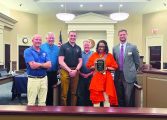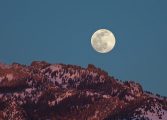By Page H. Gifford
Correspondent
“Fighting light, less light, more light,” Horace Scruggs said describing his challenges with photography. He not only discussed the challenges of photography but the creation of his vibrant work with members of the Fluvanna Art Association at their monthly meeting on May 20.
He immediately engaged them in a conversation regarding the need to create art. Many members shared their thoughts, opening up a meaningful discussion.
“It is who I am,” said Susan Edginton.
“I have to do it,” added Diane Wilkin.
“Therapy,” said Jane Prete.
“It helps me to see the world,” Mary Volin responded. Deborah Nixon echoed the same “It makes me slow down and see things around me.”
Lorraine Momper looked at it in a more intuitive “It’s having a silent conversation with other people and making connections.”
“It’s in my genes,” said Linda Napier. Wilkin added, “There are three pieces to an artist, the artist, the medium, and the viewer.”
“When I think about true art,” said Scruggs, “I think about what Michelangelo said: “True art is made noble and religious by the mind producing it.” Scruggs led the group on a journey not only to understand why we produce and create art but what inspires us. “True art is not mass-produced or stamped out.”
Scruggs began to speak about his journey of artistic discovery. As a musician, he could relate to the visual arts but as a photographer, he recognized a different set of challenges. A few members, including Prete, stated that art should tell a story. Prete added that she looks back on her art journey as it relates to her life.
“Noble art leaves room for those emotions to breathe and have their own life outside our emotions and feelings.” Creating art at different stages of life tells them where they have been, what they created, where they are now, and where they want to go.
The main element for any artist, whether it is photography, painting, or drawing is to understand the science behind art and its influence on creating mood. Scruggs said that in photography understanding f-stops was one of the critical tools he needed to produce the kind of photographs that spoke to the viewer.
“We transform light, shadows, color, perspective, the subject, and movement into reason, emotions, depth, and longing,” he said.
Grandeur was a word he used to describe one of his guiding principles of photography.
“I want you to see the grandeur, so you can fall into the picture and see the intricacy, notice the details and explore.” He adds a photographer’s mantra that “you have to be there because it’s not going to be there forever.”
Many who do landscape photography cite the master photographer Ansel Adams who famously said among his many well-known quotes, “You don’t take opportunities, you make them.” Photographers understand art in a similar way to painters but use different tools to express themselves through what they are conveying to the viewer. Learning to manipulate light and shadow with f-stops is the same as a painter manipulating the same with brushes or palette knives.
Scruggs explains the art of photography very well beginning with the critical thirds, creating depth perception and perspective in the foreground, middle ground, and background. He illustrated his point with four different shots of Crabtree Falls. At different moments or different times or even at different angles, the photos show diversity in each picture.
“Things happen without human presence and are happening during creation.” He also mentioned drone photography which gives a different angle or perspective from above.
Telling stories in art is nothing new and has provided us with a recorded history long before photography. Photography can capture the moment and tell us from a picture’s subtleties what we need to know. Scruggs showed a photo of a rock in the woods with the inscribed name of Malissa Smith, born 1851, died 1936. This was Scrugg’s grandmother, a woman born into slavery laid to rest in a family plot in what Scruggs calls Tepee Town where he grew up near Fork Union.
“It tells a story but it is a historical document.”
Members questioned the process, pointing to digital photography as suspect because few use a darkroom any longer. Some feel that there is over manipulation of images to a point of perfection and that is not a pure art form. He explains that using software on the computer is not different than the use of a darkroom to create images. Scruggs talked about his photo of Star Hollow Falls, one underexposed and the other corrected.
“If a photo is underexposed, there is information that can be processed,” he said. “I can pull out more color and definition from sunlight and in reality, it is what I saw. In the digital, I can bring out the details and balance it.” Scruggs not only explained why we create art but also better illuminated the understanding of photography as an art.




